Bright light indoor plants are perfect companions for sunlit spaces in your home, bringing life and greenery to your environment. These plants thrive in areas with abundant natural light, such as south-facing windows or well-lit rooms, making them ideal for brightening up your interiors.
Selecting the right plants for bright light conditions is essential to ensure their health and longevity. Some plants thrive in direct sunlight, while others prefer filtered or indirect light. Understanding their unique needs can help you create a vibrant and thriving indoor garden.
What Is Bright Light?
In indoor settings, bright light refers to areas that receive a high level of natural sunlight for most of the day. This can include both direct sunlight—where the sun’s rays shine directly on the plants—and strong indirect sunlight, where light reflects into the room without the harsh intensity of direct exposure.
Care Tips for Bright Light Plants
Taking care of bright light plants ensures they thrive and remain healthy. While these plants love sunny spots, they still require proper attention to watering, soil, humidity, and more to maintain their beauty and growth.
Watering: Bright light can increase evaporation, so check the soil more frequently in sunnier spaces.
Humidity: While many bright light plants tolerate normal indoor humidity, some tropical varieties (e.g., fiddle leaf figs or bird of paradise) thrive in slightly higher humidity levels.
Fertilization: Bright light plants are often active growers, so feed them with a balanced liquid fertilizer during their growing season (spring and summer).
17 Best Indoor Plants for Bright Light
Bright light indoor plants not only thrive in sunlit spaces but also enhance your home’s aesthetics. Here’s a curated list of the best options, their unique features, and light requirements:
1. Snake Plant (Sansevieria)
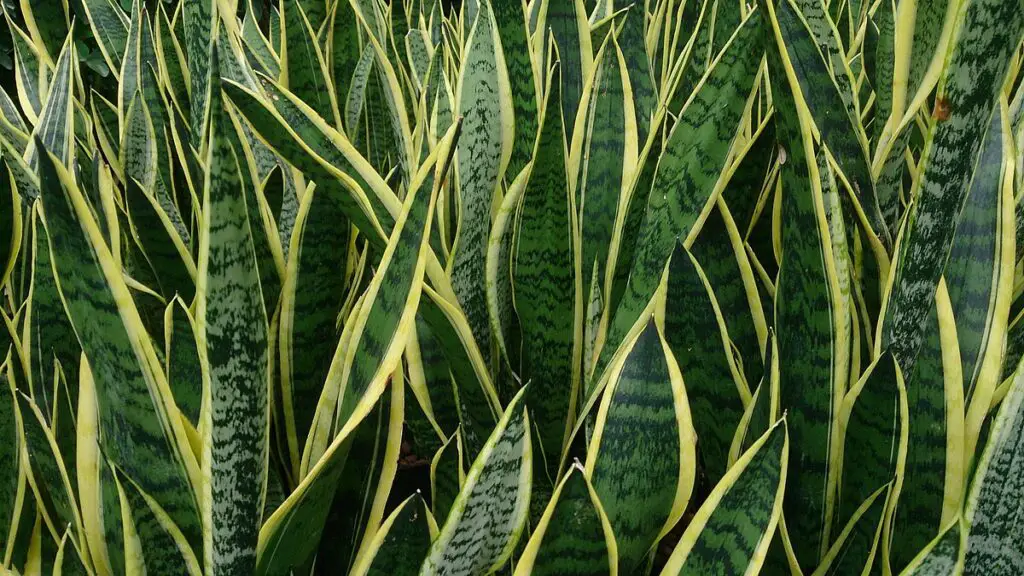
The Snake Plant, also known as the Mother-in-Law’s Tongue, is a popular choice for bright light indoor spaces due to its striking upright leaves and easy-care nature.
Key Features:
- Low Maintenance: Perfect for beginners or busy individuals, the Snake Plant requires minimal attention.
- Tolerates Neglect: It can go weeks without water, making it ideal for those who may forget to water their plants.
- Air Purifier: Known for its ability to filter toxins like formaldehyde and benzene, it improves indoor air quality.
Light Requirements:
Thrives in bright, indirect light but is highly adaptable and can tolerate low light conditions as well.
Avoid prolonged direct sunlight, as it may scorch the leaves.
Care Tips:
- Watering: Allow the soil to dry completely between waterings. Overwatering can cause root rot.
- Soil: Use well-draining soil, such as a cactus or succulent mix.
- Humidity: Tolerates standard indoor humidity levels, so no special adjustments are needed.
2. Fiddle Leaf Fig (Ficus lyrata)
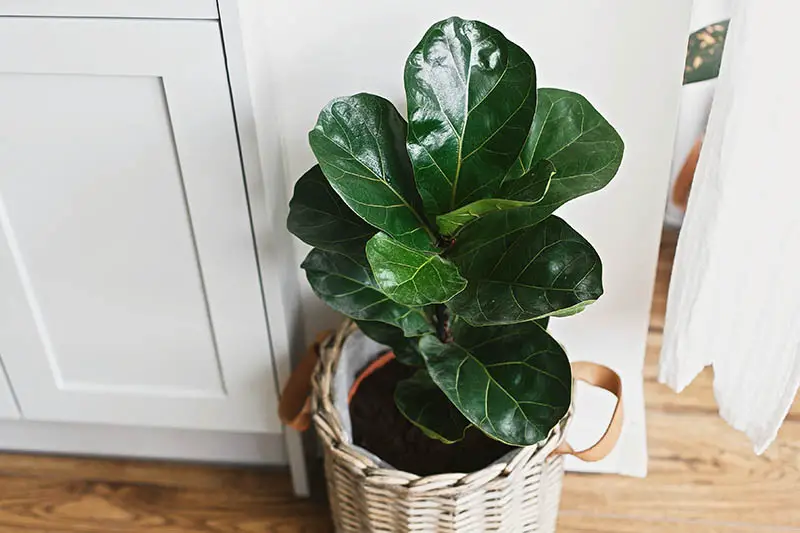
The Fiddle Leaf Fig is a stunning statement plant known for its large, violin-shaped leaves and ability to transform any room into a stylish, vibrant space.
Key Features:
- Dramatic Foliage: Its bold, glossy green leaves make it an eye-catching addition to modern interiors.
- Thrives in Bright Light: Loves direct bright light, making it perfect for well-lit living rooms, offices, or sunrooms.
Signs of Stress:
- Brown edges or spots: May indicate underwatering or low humidity.
- Yellowing leaves: This could be a sign of overwatering or poor drainage.
- Leaf drop: Often caused by drafts, low light, or sudden environmental changes.
3. Rubber Plant (Ficus elastic)
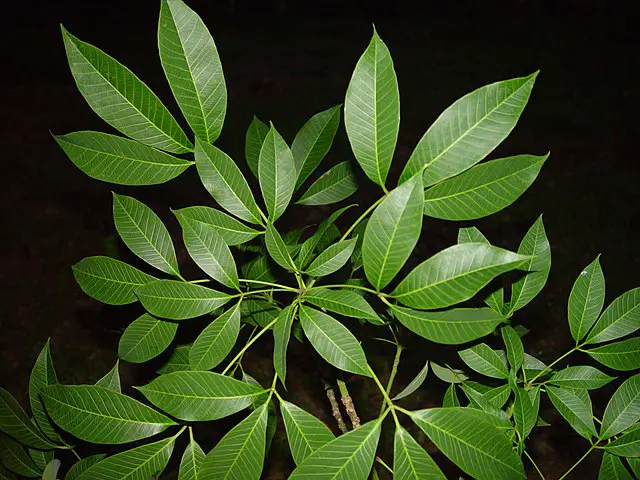
The Rubber Plant is a timeless favorite among indoor plant enthusiasts, admired for its glossy, deep green leaves and easy-care nature. It’s a versatile plant that thrives in bright spaces, adding a lush, tropical feel to any room.
Key Features:
- Glossy Leaves: Its broad, shiny foliage creates a polished, elegant look.
- Air Purifier: Known for filtering toxins and improving air quality.
- Easy to Care For: Perfect for those who want a low-maintenance plant with high visual impact.
Care Tips:
- Watering: Allow the top 1-2 inches of soil to dry before watering. Overwatering can lead to yellowing leaves or root rot.
- Humidity: Prefers moderate to high humidity; mist the leaves occasionally or use a humidifier in drier environments.
- Soil: Use a well-draining potting mix to avoid waterlogging.
- Fertilization: Feed monthly during the growing season (spring and summer) with a balanced liquid fertilizer.
Light Requirements:
- Thrives in bright, indirect light, such as near a south- or east-facing window.
- Can tolerate some direct morning sunlight but avoid harsh afternoon sun, which can scorch the leaves.
- Adapts to medium light conditions but may grow more slowly.
4. Jade Plant (Crassula ovata)
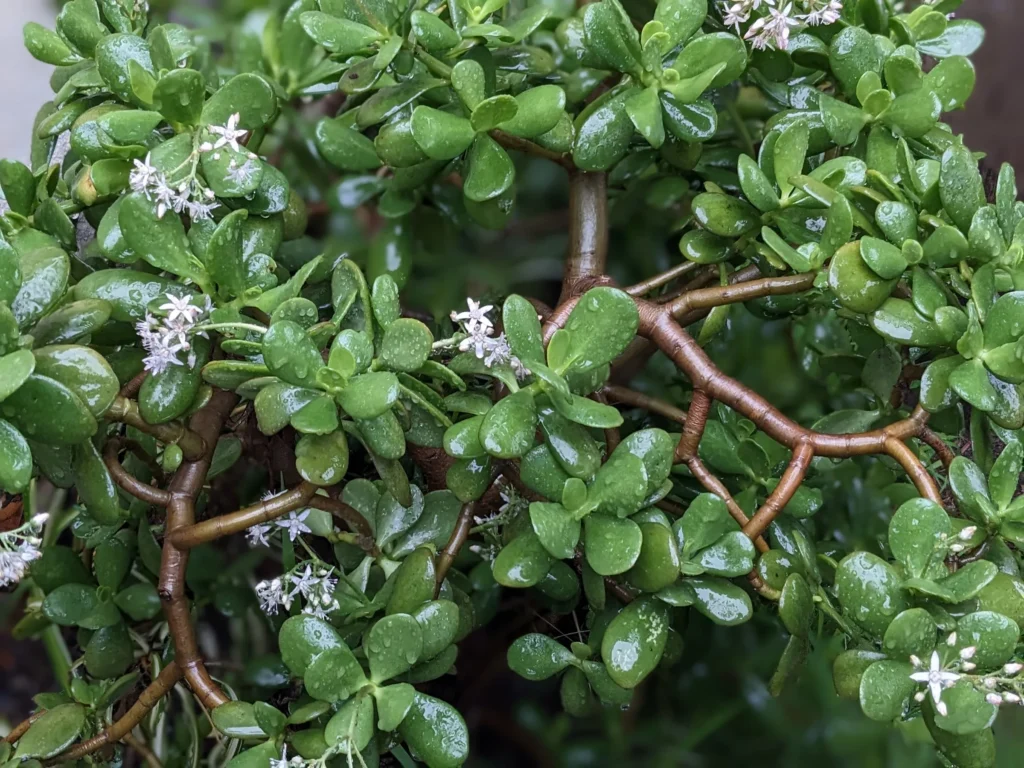
The Jade Plant is a beloved succulent known for its longevity, charm, and thick, fleshy leaves. Often considered a symbol of prosperity and good fortune, it’s a low-maintenance option perfect for bright indoor spaces.
Key Features:
- Longevity: Can live for decades with proper care, often passed down as a family heirloom.
- Charming Appearance: Compact, tree-like growth with rounded, glossy green leaves that may develop red edges in bright sunlight.
- Symbolic Meaning: Often called the “Money Plant,” it is associated with luck and prosperity.
Light Requirements:
- Thrives in bright, indirect light and enjoys a few hours of direct sunlight daily, especially morning sun.
- Place it near a south- or west-facing window for optimal growth.
- Avoid low-light conditions, as it can lead to weak, leggy growth.
Care Tips:
- Watering: Allow the soil to dry out completely between waterings. Overwatering is the most common cause of problems, as Jade Plants are drought-tolerant.
- Soil: Use a well-draining succulent or cactus mix to prevent root rot.
- Humidity: Does well in standard indoor humidity levels and does not require misting.
- Fertilization: Feed with a balanced liquid fertilizer once a month during the growing season (spring and summer).
5. Peace Lily (Spathiphyllum)
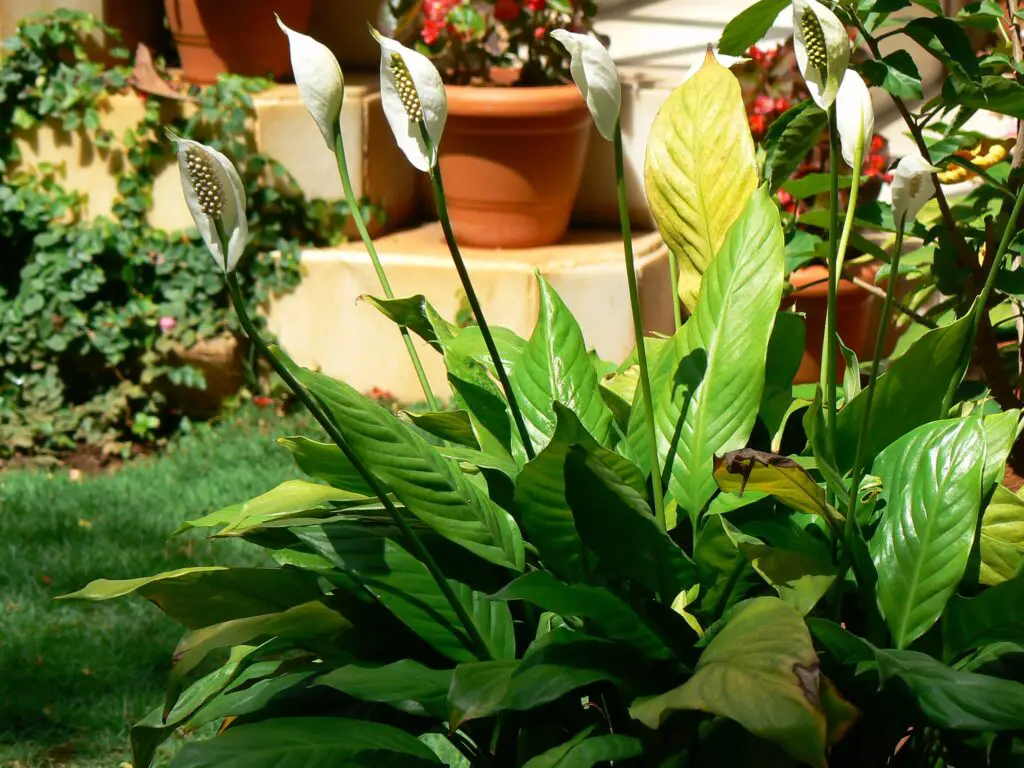
The Peace Lily is a graceful and elegant plant known for its beautiful white flowers and shiny green foliage. It is not only aesthetically pleasing but also an excellent air purifier, making it a popular choice for bright indoor spaces.
Light Requirements:
- Prefers indirect bright light, making it perfect for spaces near windows with filtered sunlight.
- Can tolerate low light conditions, but it will flower more consistently in brighter light.
- Avoid direct sunlight, as it can scorch the leaves and cause browning.
6. Bird of Paradise (Strelitzia reginae)
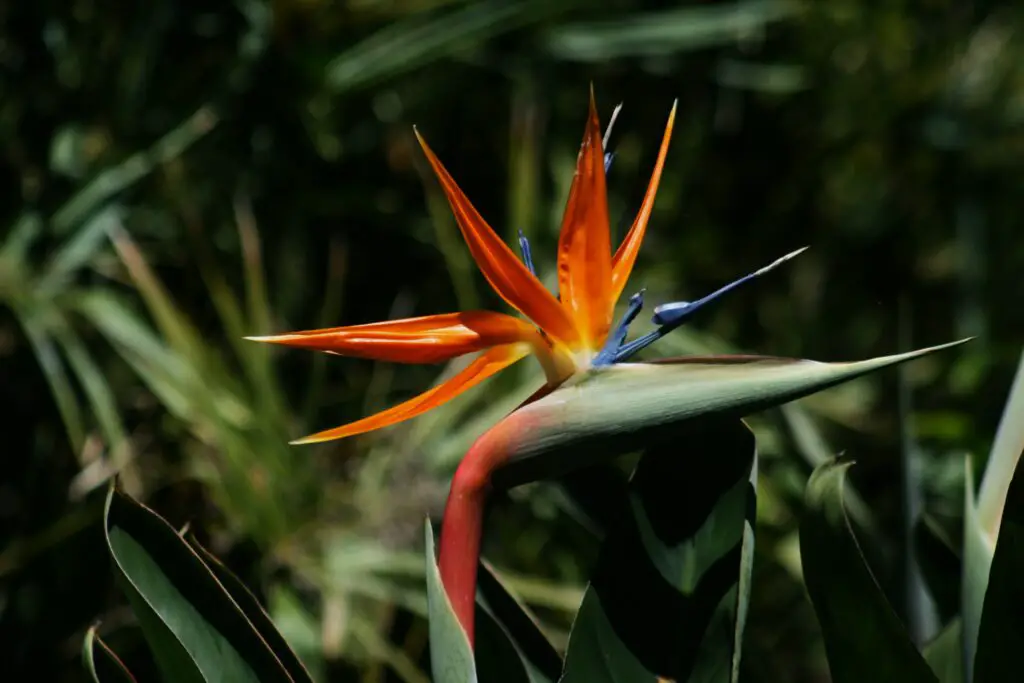
The Bird of Paradise is a bold, tropical plant known for its striking, bird-like flowers and large, lush leaves. Often considered a symbol of paradise, it adds an exotic flair to any bright indoor space, making it a standout in any room.
Key Features:
- Stunning Flowers: The plant’s unique, vibrant flowers resemble the head of a tropical bird, with orange and blue hues that bring dramatic color to your space.
- Tropical Appeal: Large, banana-like leaves give the plant a lush, tropical look, perfect for adding greenery to sun-drenched areas.
- Slow-growing: While it can grow quite large over time, it’s a slow grower, making it manageable for indoor spaces.
Care Tips:
- Watering: Water regularly during the growing season (spring and summer), but allow the soil to dry out between waterings. During the winter, reduce watering as the plant’s growth slows.
- Soil: Use a well-draining potting mix to avoid waterlogging. A mix designed for tropical plants or palms works well.
- Humidity: Enjoys moderate to high humidity; consider misting the leaves or placing the plant on a humidity tray if your indoor air is dry.
- Fertilization: Feed monthly with a balanced fertilizer during the growing season to encourage strong growth and vibrant blooms.
7. Areca Palm (Dypsis lutescens)

The Areca Palm, also known as the Yellow Palm or Butterfly Palm, is a popular tropical plant prized for its feathery, arching fronds and ability to purify the air. It brings a touch of the tropics to any bright indoor space, making it an excellent choice for bright, well-lit rooms.
Key Features:
- Air Purifier: Known for its ability to filter toxins like xylene, toluene, and formaldehyde, improving indoor air quality.
- Lush, Feathery Fronds: The graceful, arching fronds give the plant a tropical, elegant appearance.
- Easy Care: Despite its tropical origins, the Areca Palm is relatively easy to care for, making it perfect for both beginners and experienced plant owners.
Light Requirements:
- Thrives in consistent bright light, ideally near a south- or east-facing window.
- It can tolerate some indirect light but will grow more slowly and may lose some of its vibrancy in lower light conditions.
- Avoid placing it in low light, as it can lead to yellowing leaves or stunted growth.
8. Money Tree (Pachira aquatic)
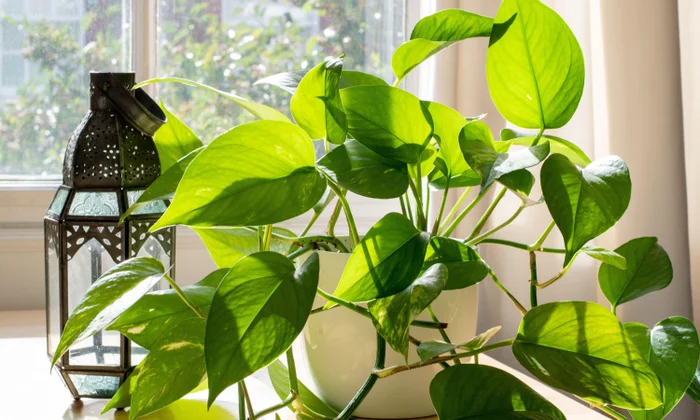
The Money Tree is a beloved plant often associated with prosperity and good fortune. With its braided trunk and lush green leaves, it’s not only an attractive addition to any home or office but also a symbol of positive energy and luck.
Key Features:
- Symbol of Luck: In Feng Shui, the Money Tree is thought to bring wealth, success, and positive energy to its owner.
- Braided Trunk: One of the most distinctive features, its trunk is often braided or twisted, making it a unique, ornamental plant.
- Easy to Care For: This low-maintenance plant thrives in a variety of indoor settings, making it perfect for busy individuals or those new to plant care.
Light Requirements:
- Loves bright, filtered sunlight—ideal for locations with indirect light from a south- or west-facing window.
- Can tolerate low light, but its growth may slow down, and the leaves may become less vibrant in dimmer conditions.
- Avoid direct sunlight, as it can scorch the delicate leaves.
9. Croton (Codiaeum variegatum)
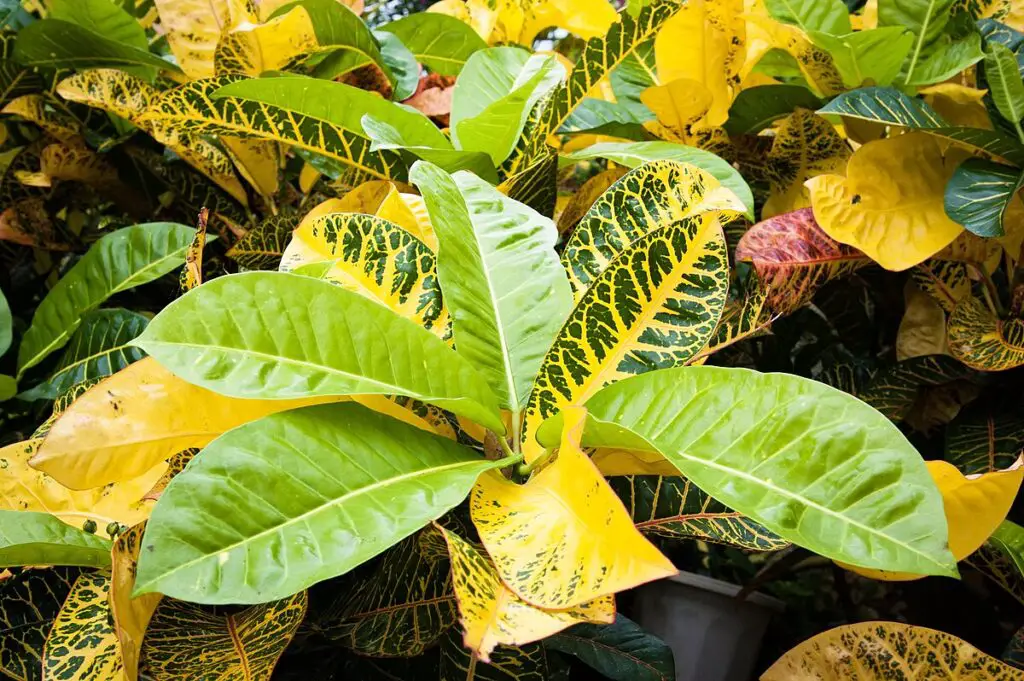
The Croton is a striking, colorful plant known for its vibrant, multi-colored foliage. It’s a bold choice for bright indoor spaces, adding rich hues of yellow, orange, red, and green to any room. Its dramatic appearance and eye-catching colors make it a standout in any collection of houseplants.
Key Features:
- Vibrant Foliage: The Croton’s leaves feature a mix of bright yellows, oranges, reds, and greens, which change as the plant matures, creating a dynamic, constantly evolving look.
- Tropical Appeal: With its lush, bushy growth and colorful foliage, it brings a touch of the tropics indoors.
- Decorative Impact: Known for its bold, ornamental beauty, the Croton is often used as a focal point in interior design.
Care Tips:
- Watering: Water when the top 1-2 inches of soil are dry. Be careful not to overwater, as this can cause root rot.
- Soil: Use a well-draining potting mix to prevent excess moisture around the roots. A mix formulated for tropical plants works well.
- Humidity: Crotons thrive in higher humidity levels, so consider misting the leaves or placing the plant on a humidity tray to keep it happy in drier indoor environments.
- Fertilization: Feed monthly during the growing season (spring and summer) with a balanced liquid fertilizer to support the plant’s vibrant growth.
10. Succulents (Various Types)
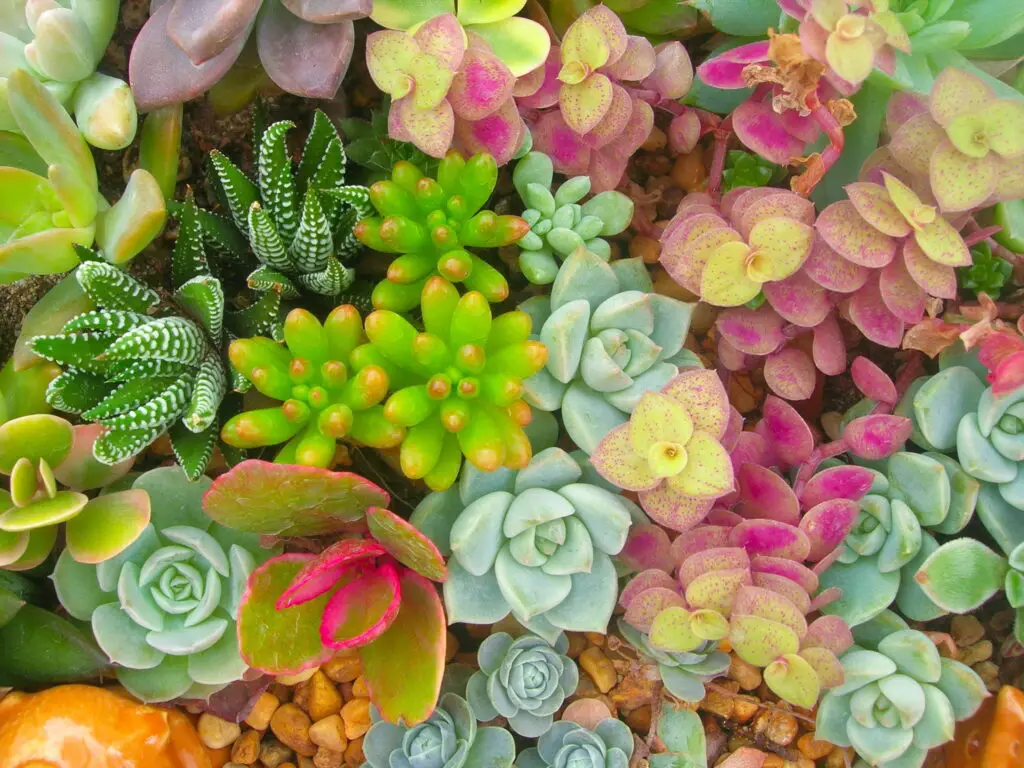
Succulents are a diverse group of plants known for their fleshy, water-storing leaves, which help them thrive in dry, sunny environments. Popular varieties like Aloe Vera, Echeveria, and many others are perfect for bright indoor spaces, offering unique shapes, textures, and colors.
There are many different types of succulents, with hundreds of species available to choose from. Here’s a list of some popular varieties:
- Aloe Vera – Known for its medicinal properties and thick, fleshy leaves.
- Echeveria – Popular for its rosette shape and vibrant colors.
- Jade Plant (Crassula ovata) – A tree-like succulent with thick, glossy leaves.
- Sedum – Varieties like Sedum morganianum (Burro’s Tail) are known for their trailing growth.
- Hens and Chicks (Sempervivum) – Forms rosettes of leaves that multiply over time.
- Agave – Known for its spiky leaves and architectural appearance.
- String of Pearls (Senecio rowleyanus) – A trailing succulent with round, bead-like leaves.
- Cactus (Various types) – Includes popular varieties like Prickly Pear and Barrel Cactus.
- Kalanchoe – Includes species like Kalanchoe thyrsiflora, known for its colorful foliage.
- Pachyphytum – A small, smooth-leaved succulent.
- Crassula perforata (String of Buttons) – A compact succulent with stacked, button-like leaves.
- Aeonium – Known for its rosette shape and colorful foliage, especially in sun.
- Lithops – Also called “living stones,” these plants resemble rocks and blend in with their environment.
- Senecio (Various species) – Includes Senecio radicans (String of Bananas).
- Topsy Turvy (Crassula perfoliata var. falcata) – Known for its unique, upward-curved leaves.
Succulents vary widely in size, shape, and color, and they all share the characteristic of storing water in their leaves. They’re versatile, requiring minimal care, and are perfect for bright indoor spaces.
Succulents like Aloe Vera, Echeveria, and Sedum are easy to care for and thrive in bright indoor environments. Their unique shapes and colors make them a fantastic choice for adding a touch of desert charm to your home.
11. String of Pearls (Senecio rowleyanus)
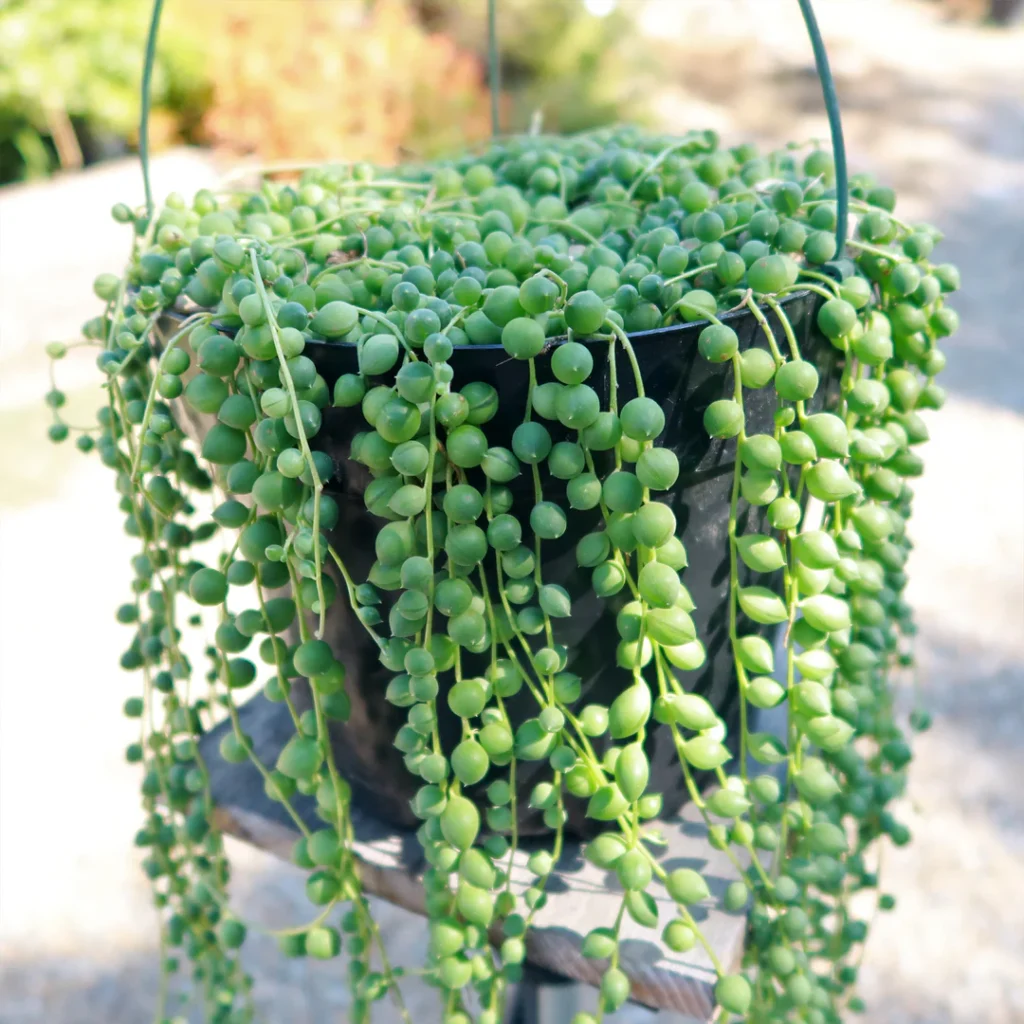
The String of Pearls is a distinctive, cascading succulent known for its unique appearance, with pearl-like beads that trail down long, thin stems. This plant is perfect for hanging baskets or windowsills, where it can spill over beautifully, making it a striking addition to bright indoor spaces.
Key Features:
- Beaded Leaves: Its leaves resemble small, round pearls or beads, giving it a whimsical and eye-catching look.
- Cascading Growth: It grows long, trailing stems, often cascading down from containers, making it ideal for hanging pots or shelves.
- Low Maintenance: Like most succulents, it’s easy to care for and can withstand some neglect, making it perfect for those new to plant care.
Care Tips:
- Watering: Water thoroughly when the soil is completely dry, but avoid letting the plant sit in water. String of Pearls are highly susceptible to root rot if overwatered, so be sure to allow the soil to dry out between waterings.
- Soil: Use a well-draining cactus or succulent mix to ensure proper drainage.
- Humidity: This plant prefers dry conditions and doesn’t need high humidity. In fact, it’s more likely to suffer from excess moisture than from dry air.
- Fertilization: Feed monthly with a diluted liquid fertilizer during the growing season (spring and summer). Avoid fertilizing in the winter when the plant is dormant.
12. Cacti (Various Types)
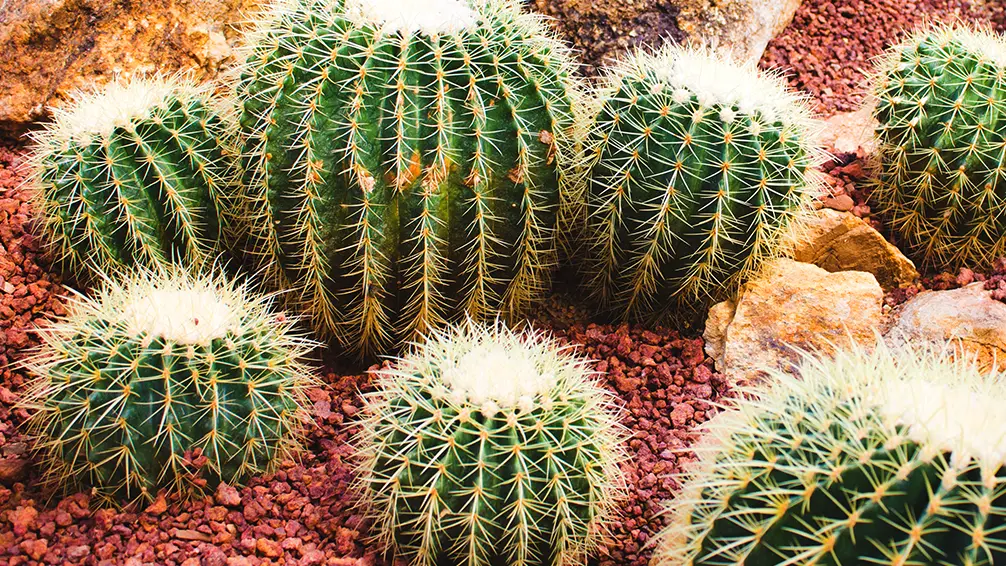
Cacti are hardy, low-maintenance plants that thrive in bright, direct sunlight. Known for their spiny, unique appearance and ability to survive in arid conditions, cacti make excellent additions to sunny indoor spaces. From small potted varieties to large, statement pieces, they come in a variety of shapes and sizes to suit any home.
Benefits of Cacti:
- Low Maintenance: Cacti are incredibly forgiving and require little care. Their infrequent watering needs make them perfect for busy individuals or those new to gardening.
- Air Purification: Like many houseplants, cacti help purify the air by absorbing carbon dioxide and releasing oxygen.
- Aesthetic Appeal: With their sculptural, geometric shapes, cacti can add a modern or desert-inspired touch to your decor. They come in a variety of colors and sizes, making them suitable for any design style.
- Long Lifespan: Cacti are long-lived plants that can survive for many years with proper care, making them a lasting investment for your home.
- Flowering: Many cacti species bloom in the spring or summer, offering beautiful, vibrant flowers that contrast with their spiny stems, adding color to your space.
- Stress Relief: Studies show that having indoor plants, including cacti, can help reduce stress and improve your mood, making them great companions in your living or working environment.
- Low Water Usage: Cacti are drought-tolerant and require minimal water compared to other indoor plants, making them an eco-friendly choice for sustainable living.
- Cacti are ideal for anyone looking for a beautiful, low-maintenance plant that thrives in bright, sunny spaces. With their unique form, stunning flowers, and air-purifying properties, cacti are a rewarding addition to any indoor garden.
13. ZZ Plant (Zamioculcas zamiifolia)
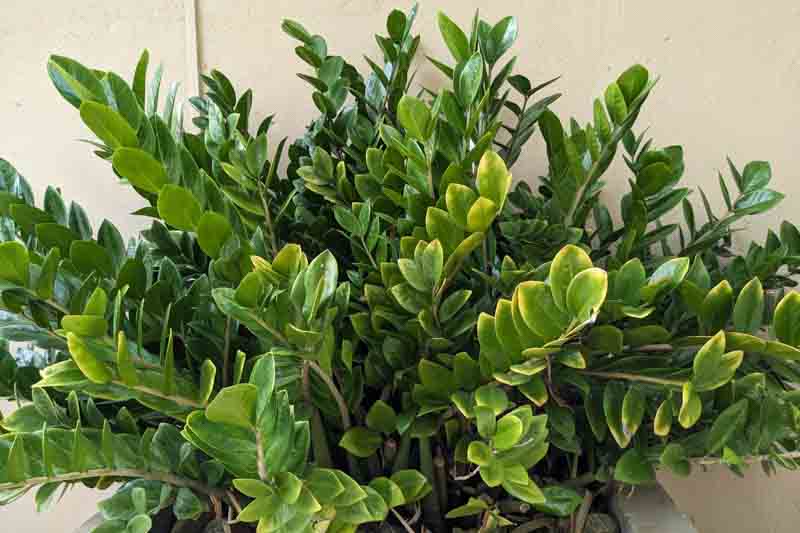
The ZZ Plant is a versatile and resilient plant that thrives in various lighting conditions, making it perfect for both bright and lower-light spaces. Known for its glossy, dark green leaves and its ability to adapt to different environments, the ZZ Plant is a popular choice for anyone looking for a low-maintenance yet striking addition to their home.
Benefits of ZZ Plant:
- Low Maintenance: ZZ Plants are incredibly easy to care for and don’t require frequent watering or special care. They can go for weeks without attention, making them ideal for busy people or beginners.
- Air Purification: Like many houseplants, the ZZ Plant helps purify the air by absorbing toxins such as benzene, toluene, and xylene, and releasing oxygen.
- Stress Reduction: Studies have shown that indoor plants like the ZZ Plant help reduce stress and improve mood, making it perfect for home or office spaces.
- Durability: The ZZ Plant is known for being resilient, handling neglect better than many other plants. It can withstand dry air, occasional underwatering, and fluctuations in temperature.
- Long Lifespan: ZZ Plants are slow-growing but long-lived, often thriving for many years with little care, making them a lasting addition to your home.
- Aesthetic Appeal: The plant’s glossy, dark green leaves and upright growth habit make it a beautiful and decorative addition to modern home interiors. It’s often used in contemporary design for its sleek, minimalist appearance.
- Pet-Friendly (Non-Toxic): Unlike some plants, the ZZ Plant is non-toxic to pets, making it a safe choice for households with cats or dogs.
Decoration Ideas:
- Statement Piece: The ZZ Plant’s bold, glossy leaves make it a great centerpiece for any room. It can be displayed in a decorative pot in a living room, hallway, or office to add sophistication and style.
- Desk Plant: Its ability to tolerate low light makes it ideal for offices or workspaces with artificial lighting. Place it on a desk, bookshelf, or filing cabinet to add greenery to your workspace.
- Pair with Modern Decor: The ZZ Plant complements modern, minimalist decor. Pair it with sleek, geometric pots and clean lines to create a chic, contemporary look.
- Accent in a Corner: It also works well as a statement plant in a corner of a room, standing tall and elegant.
- Bathroom Decor: If your bathroom gets some natural light, the ZZ Plant can thrive there and add a refreshing touch of greenery to the space.
Care Tips:
- Watering: Water the ZZ Plant only when the soil is completely dry. Overwatering can lead to root rot, so ensure the pot has drainage holes to prevent excess moisture.
- Soil: Use a well-draining potting mix, such as a cactus or succulent blend, to ensure the plant’s roots aren’t waterlogged.
- Fertilization: Feed the plant once or twice during the growing season (spring and summer) with a balanced, diluted liquid fertilizer.
- Humidity: The ZZ Plant doesn’t require high humidity and can tolerate dry indoor conditions, making it ideal for homes with low humidity or air-conditioned spaces.
14. Anthurium

Anthurium, also known as the flamingo flower or laceleaf, is a striking plant prized for its bright, glossy flowers and elegant appearance. Known for its long-lasting blooms, it adds a touch of sophistication and color to any indoor space. This tropical plant thrives in indirect bright light, making it perfect for homes with well-lit areas but not direct sunlight.
Benefits of Anthurium:
- Long-Lasting Blooms: The Anthurium is known for producing vibrant flowers that can last for months, brightening any room with little effort.
- Air Purification: Anthuriums help improve indoor air quality by removing harmful toxins like formaldehyde, ammonia, and xylene, making them perfect for homes, offices, and other indoor spaces.
- Aesthetic Appeal: With its shiny, heart-shaped leaves and stunning blooms, the Anthurium is a beautiful ornamental plant that adds elegance and color to any space.
- Mood Enhancement: The bright, cheerful flowers of the Anthurium are said to enhance mood and create a positive, uplifting atmosphere in your home or office.
- Low Maintenance: While it does require some attention to thrive, the Anthurium is relatively easy to care for compared to other flowering plants.
- Tropical Touch: Its lush, vibrant appearance makes it a perfect addition to create a tropical ambiance indoors, transporting a bit of paradise into your home.
- Pet-Friendly (Non-Toxic to Cats and Dogs): The Anthurium is non-toxic to cats and dogs, making it safe for households with pets.
Decoration Ideas:
- Statement Plant: Due to its bold flowers and attractive foliage, the Anthurium can be a stunning statement piece in your living room, dining area, or office. It looks fantastic in a decorative pot or planter placed in a prominent location.
- Centerpiece for Tables: The Anthurium’s colorful blooms make it an excellent choice for a table centerpiece, adding instant color and vibrancy to a dining or coffee table.
- Tropical Focal Point: Create a tropical oasis in your home by grouping Anthuriums with other tropical plants like ferns, palms, and orchids. The contrast of their lush, glossy leaves and bright flowers enhances the tropical vibe.
- Decorative Pot: Choose a stylish pot or planter to enhance the plant’s elegant look. Anthuriums pair well with sleek, minimalist planters in neutral colors, or you can opt for a bold, colorful pot that complements the plant’s flowers.
- Office Desk: Brighten up your office space with an Anthurium, which will not only add beauty but can also boost your mood and improve air quality while you work.
Key Features:
- Bright Flowers: The standout feature of the Anthurium is its vivid, red, pink, or white spathes (modified leaves) and yellow spadix (flower spike), which resemble a “flamingo’s” head, adding bold color to your home.
- Glossy, Dark Green Leaves: The deep green foliage of the Anthurium complements its bright flowers and adds to its lush, tropical aesthetic.
- Long-Lasting Blooms: Unlike many houseplants, the flowers of the Anthurium can last for several months, adding long-term beauty to your space.
- Air-Purifying: Like many other houseplants, Anthuriums contribute to cleaner indoor air by filtering toxins and promoting oxygen flow.
Light Requirements:
- Indirect Bright Light: Anthuriums thrive in bright, indirect light. While they can tolerate some direct sunlight, prolonged exposure may scorch their leaves and cause the flowers to fade prematurely.
- Ideal spots include east- or north-facing windows where the plant can receive bright, filtered light throughout the day.
- In lower light, the plant may still survive, but it will produce fewer flowers and grow more slowly.
Care Tips:
- Watering: Keep the soil consistently moist but not soggy. Water the plant when the top inch of soil feels dry to the touch. Avoid letting the plant sit in water, as it can lead to root rot.
- Soil: Use a well-draining potting mix, such as one formulated for tropical plants. The plant prefers slightly acidic soil.
- Humidity: Anthuriums thrive in moderate to high humidity. Increase humidity by misting the leaves, using a humidifier, or placing the plant on a pebble tray filled with water.
- Fertilization: Feed the Anthurium monthly during the growing season (spring through summer) with a balanced liquid fertilizer. Cut back on fertilization during the dormant winter months.
- Pruning: Remove dead or wilting flowers to encourage new blooms and maintain the plant’s attractive appearance. Cut back any yellow or brown leaves as needed.
Signs of Stress:
- Yellow Leaves: This may indicate overwatering, poor drainage, or low light.
- Wilted or Drooping Flowers: Often a sign of insufficient water or humidity.
- Brown Leaf Tips: This can happen if the plant is exposed to dry air, or the soil has dried out too much between waterings.
Anthuriums are perfect for adding a burst of color and elegance to your indoor garden. With their long-lasting flowers, air-purifying qualities, and easy care, they’re a great choice for anyone looking to brighten up their home with a tropical touch.
15. Spider Plant (Chlorophytum comosum)
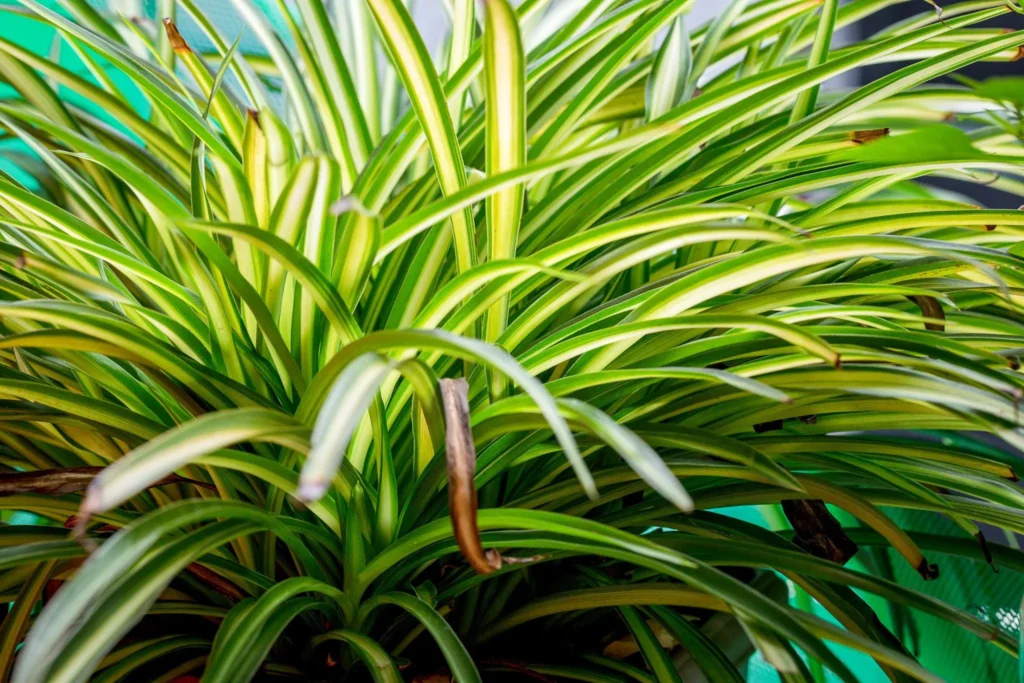
The Spider Plant is a popular and easy-to-care-for houseplant, known for its hardiness, adaptability, and unique appearance. Its long, arching green and white-striped leaves create a beautiful, cascading effect that adds movement and vibrancy to any room. It’s especially great for beginners due to its resilience and low-maintenance care requirements.
Key Features:
- Arching Green and White Stripes: The plant’s signature feature is its long, narrow leaves, which grow in a rosette pattern and often have striking white stripes running along them.
- Spider-Like Offsets: The Spider Plant produces small “babies” or offshoots that dangle from long stems, resembling spiders hanging from a web, which is where the plant gets its name. These can be propagated into new plants.
- Air Purification: The Spider Plant is excellent at purifying the air, removing toxins such as formaldehyde and xylene from indoor spaces.
Benefits of Spider Plant:
- Air Purification: Like many houseplants, the Spider Plant is known for its ability to purify the air, removing harmful chemicals such as formaldehyde, carbon monoxide, and xylene.
- Low Maintenance: It’s an ideal plant for beginners or people who don’t have a lot of time for plant care. Spider Plants don’t require frequent watering and can tolerate some neglect.
- Stress Reduction: Studies show that having plants like the Spider Plant indoors can help reduce stress levels and improve overall well-being.
- Non-Toxic to Pets: The Spider Plant is safe for pets, making it an excellent choice for households with cats and dogs.
- Easy Propagation: The plant’s offshoots or “babies” are easy to propagate, allowing you to grow new plants and share them with friends or family.
- Versatile and Adaptable: The Spider Plant is well-suited for a variety of indoor environments, from homes to offices. It can thrive in both hanging baskets or on shelves and tables.
- Attractive Appearance: The cascading foliage, along with the arching leaves and unique spider-like offshoots, makes the Spider Plant a decorative feature that adds visual interest to any room.
16. Bromeliads
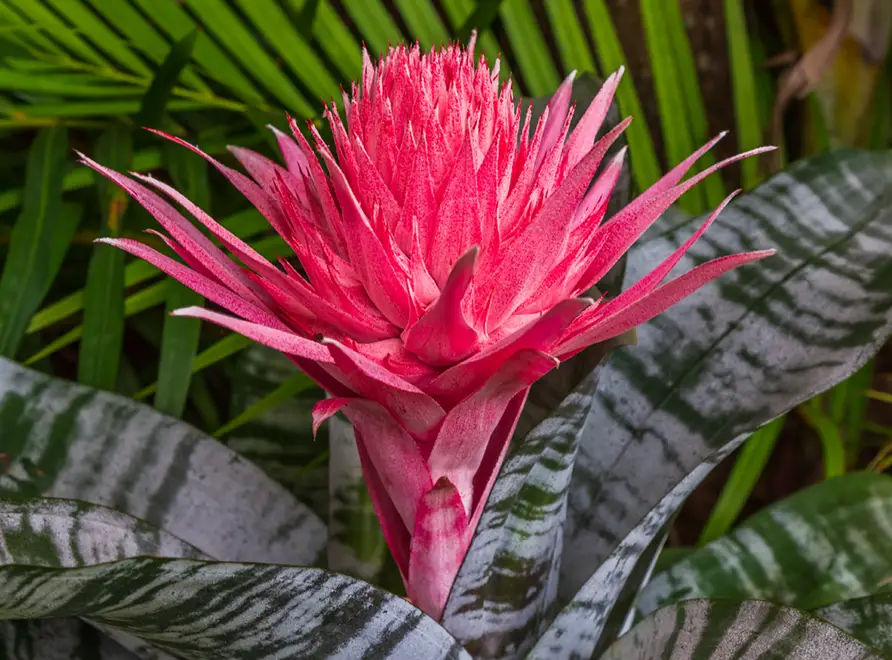
Bromeliads are exotic, colorful plants known for their vivid blooms and unique foliage. With their bright, vibrant flowers and ability to thrive in bright, indirect light, Bromeliads are a fantastic choice for adding a tropical touch to your indoor space. These plants come in a variety of colors, including red, pink, orange, and yellow, which make them stand out as striking focal points in any room.
Key Features:
- Colorful, Long-Lasting Blooms: Bromeliads are known for their stunning flowers that can last for several weeks or even months. The flowers come in a variety of bright colors like red, pink, purple, and yellow. The leaves surrounding the flowers are often vibrant, adding extra appeal to the plant.
- Foliage: The leaves of Bromeliads are often rosettes that are green, striped, or variegated, giving the plant a unique, architectural appearance.
- Tropical Appeal: Bromeliads are native to tropical regions, and their appearance can immediately create a lush, vibrant, and tropical atmosphere in your home.
- Epiphytic Nature: Many Bromeliads grow as epiphytes, meaning they can live on other surfaces like trees or rocks in their natural habitat, absorbing moisture and nutrients from the air. This makes them highly adaptable to indoor environments.
Benefits of Bromeliads:
- Vibrant and Unique Appearance: The colorful blooms and tropical aesthetic of Bromeliads make them an eye-catching addition to any home or office. They can serve as a statement piece in your indoor garden.
- Long-Lasting Blooms: Unlike many houseplants, Bromeliads have long-lasting flowers that stay vibrant for weeks or even months, brightening up your space for an extended period.
- Low Maintenance: Bromeliads are relatively easy to care for. They don’t need frequent watering, and they thrive in low-maintenance environments as long as their basic needs are met.
- Air Purification: Like many other houseplants, Bromeliads help purify the air, removing toxins and promoting a healthier indoor environment.
- Adaptability: Bromeliads are adaptable to different light conditions and can thrive in a variety of environments, including homes, offices, and even bathrooms with bright light.
- Non-Toxic to Pets: Bromeliads are non-toxic to pets, making them a safe option for homes with cats or dogs.
- Tropical Vibe: The bright, colorful flowers and lush foliage create an instant tropical feel, making them perfect for bringing some warmth and color into colder months.
Signs of Stress:
- Fading Flowers: If the blooms start to fade, it may indicate that the plant has finished its blooming cycle, which is natural. You can trim off the spent flowers, and new blooms may appear.
- Yellowing Leaves: Yellowing leaves can indicate overwatering or that the plant is getting too much direct sunlight.
- Wilting or Dry Leaves: This could be a sign that the plant isn’t receiving enough water or humidity, or that it’s too dry around the roots.
17. Chinese Evergreen (Aglaonema)
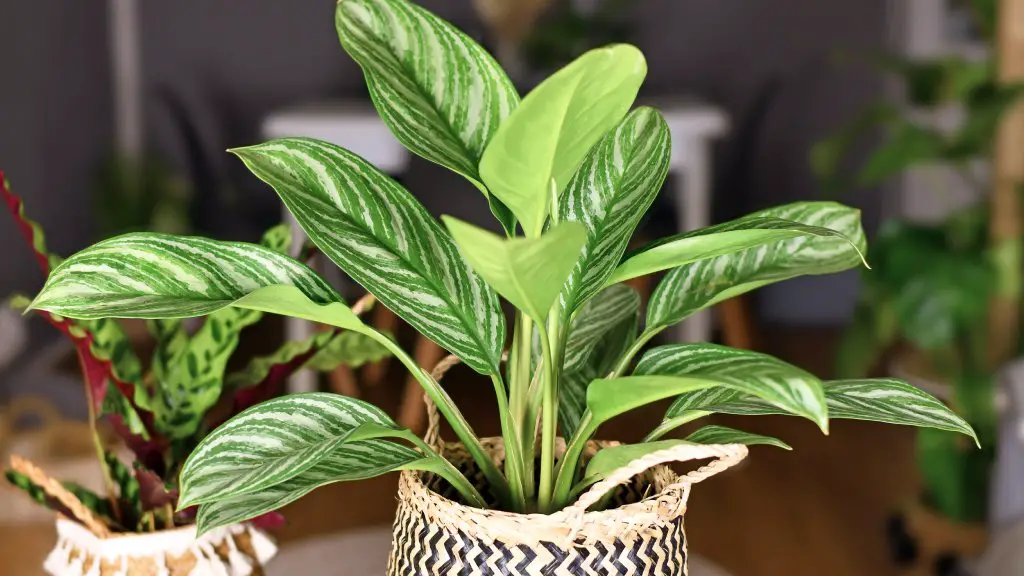
The Chinese Evergreen (Aglaonema) is a highly resilient, easy-care plant known for its striking patterned leaves and adaptability to low-maintenance environments.
With its lush, variegated foliage in shades of green, silver, and even red, the Chinese Evergreen adds a touch of elegance and beauty to any indoor space. This plant is especially suited for those looking for an attractive, low-maintenance houseplant that thrives in a variety of lighting conditions.
Chinese Evergreen (Aglaonema)
The Chinese Evergreen (Aglaonema) is a highly resilient, easy-care plant known for its striking patterned leaves and adaptability to low-maintenance environments. With its lush, variegated foliage in shades of green, silver, and even red, the Chinese Evergreen adds a touch of elegance and beauty to any indoor space. This plant is especially suited for those looking for an attractive, low-maintenance houseplant that thrives in a variety of lighting conditions.
Benefits of Chinese Evergreen:
- Low Maintenance: The Chinese Evergreen is one of the easiest houseplants to care for. It’s perfect for beginners or people who don’t have a lot of time to dedicate to plant care.
- Air Purification: Chinese Evergreens are known for improving indoor air quality by removing toxins like formaldehyde and benzene from the air.
- Tolerant to Low Light: Unlike many other houseplants, Chinese Evergreens thrive in low light conditions, making them ideal for areas with limited natural sunlight.
- Decorative Appeal: With its beautifully patterned leaves and variety of colors, the Chinese Evergreen adds elegance and visual interest to any room, making it a stylish addition to your decor.
- Pet-Friendly: Aglaonema is non-toxic to pets, making it a great option for homes with cats or dogs.
- Versatility: This plant is extremely versatile, fitting easily into different environments and rooms, whether you want to place it in your living room, office, or bedroom.
Signs of Stress:
- Yellowing Leaves: This could be a sign of overwatering or insufficient light. Adjust your watering schedule and move the plant to a location with more indirect light if necessary.
- Brown Leaf Tips: This may be caused by low humidity or inconsistent watering. Increase humidity by misting or placing the plant on a humidity tray.
- Stunted Growth: If the plant’s growth slows or becomes leggy, it may not be getting enough light. Try moving it to a brighter location or adjust its care routine.
- Chinese Evergreens are a wonderful addition to any home, offering both aesthetic appeal and air-purifying benefits with minimal care. Whether you’re new to houseplants or an experienced plant parent, Aglaonema’s toughness and adaptability make it an excellent choice for a variety of indoor environments.
Related Topics:
Common Mistakes to Avoid with Bright Light Plants
When caring for indoor plants that thrive in bright light, it’s easy to make some common mistakes that can hinder their growth and overall health. Here are a few things to watch out for:
Overwatering or Underwatering
- Overwatering: Bright light plants, like all plants, need water, but too much can lead to root rot and other health issues. Overwatering can cause the roots to suffocate, as the soil doesn’t have enough time to dry out between waterings. Always ensure the soil has proper drainage and check that the top 1-2 inches of soil are dry before watering again.
- Underwatering: On the flip side, letting the plant sit in dry soil for too long can lead to wilting and yellowing leaves. Plants that require bright light typically need more frequent watering, but it’s essential to gauge the specific needs of each plant.
- Tip: Use a moisture meter or simply check the soil with your finger to determine if it’s time to water.
Placing Plants Too Close to Windows or Heat Sources
- Direct Sunlight: While bright light plants thrive in abundant light, direct sunlight can be too harsh for some plants, especially those with delicate leaves. Too much direct sunlight can scorch the leaves, causing brown spots or faded foliage. Always make sure to position the plant in a place where it gets filtered or indirect light—for example, near a window with sheer curtains or a few feet away from direct sun exposure.
- Heat Sources: Placing plants too close to heaters, radiators, or air conditioners can expose them to fluctuating temperatures and dry air, which stresses the plant. Sudden temperature changes can cause the leaves to drop or become discolored.
- Tip: Try to place plants in a stable environment with steady temperatures and indirect sunlight.
Neglecting the Need for Occasional Repotting and Pruning
- Repotting: Plants need space to grow, and over time, they can become root-bound in their pots. If you neglect to repot your plants when they outgrow their current containers, they may stop thriving. Roots can suffocate in a small pot, restricting growth and nutrient absorption.
- Tip: Check for signs that your plant is root-bound, like roots growing out of drainage holes or stagnant growth. Repot your plants every 1-2 years, or when needed, using a slightly larger pot and fresh, well-draining soil.
- Pruning: Regular pruning helps remove dead or yellowing leaves, encourages new growth, and improves the overall shape of the plant. Neglecting to prune can lead to leggy growth or an unhealthy appearance.
- Tip: Trim dead or damaged leaves and stems with clean scissors or pruning shears. This helps the plant redirect energy to healthier growth.
How to Display Bright Light Plants Indoors
Displaying your bright light plants indoors is not only about giving them the best growing conditions but also about integrating them into your home decor. Here are some tips and ideas for effectively showcasing your plants while enhancing the overall aesthetic of your space:
Ideas for Placement:
- Shelves are a fantastic way to display multiple plants in a small or large space. They allow you to create a layered look, adding dimension and visual interest. Place your bright light plants on floating or tiered shelves near windows that receive indirect sunlight.
- Hanging Pots or planters are an excellent solution for space-saving and can add a unique visual element to your room. Hang plants in decorative pots near bright windows or in corner spaces where they can still receive ample light.
- Plant Stands are versatile and can elevate your plants to eye level, showcasing their foliage and making them the focal point of a room. For tall plants like Areca Palms or Rubber Plants, use stands to give them extra height. Smaller plants can be displayed on multi-tiered stands or grouped together on a single stand for a cohesive look.
Designing a Well-Lit Plant Corner for Aesthetics and Functionality:
Creating a plant corner that is both functional and aesthetically pleasing can turn a dull space into a green oasis. Here’s how to design a dedicated plant space that maximizes both the health of your plants and the beauty of your room:
- Select the Right Location
- Create Vertical Interest
- Incorporate Plant Lighting
- Group Plants by Size and Type
- Use Decorative Containers
- Add Other Decorative Elements
- Maintenance and Accessibility
By considering both aesthetic appeal and functionality, you can create a stunning plant corner that not only enhances your space but also provides an ideal environment for your bright light plants. Whether you’re using shelves, hanging pots, or plant stands, displaying your plants thoughtfully will add a refreshing touch to your home.
Conclusion
Bright light plants are a fantastic way to bring nature into your home while enhancing both the aesthetic and health of your indoor space. Whether you’re adding lush greenery with dramatic foliage like a Fiddle Leaf Fig or creating a unique touch with a String of Pearls, these plants not only purify the air but also add beauty and tranquility to any room.
Encouragement to Experiment: Don’t be afraid to experiment with different plant varieties and placements! Every plant has its own unique characteristics, and by mixing different types of bright light plants, you can create a dynamic, ever-changing indoor garden. Whether you’re a beginner or an experienced plant lover, there’s always room to explore new varieties and design your space with fresh, lush plants.
Reminder: To ensure your bright light plants thrive, remember to monitor light levels, adjust watering schedules, and keep an eye on their care needs. With the right attention to their individual requirements, your plants will flourish and bring lasting beauty to your home.
So, enjoy the process, experiment with different combinations, and watch your bright light plants thrive in your indoor garden! 🌿✨

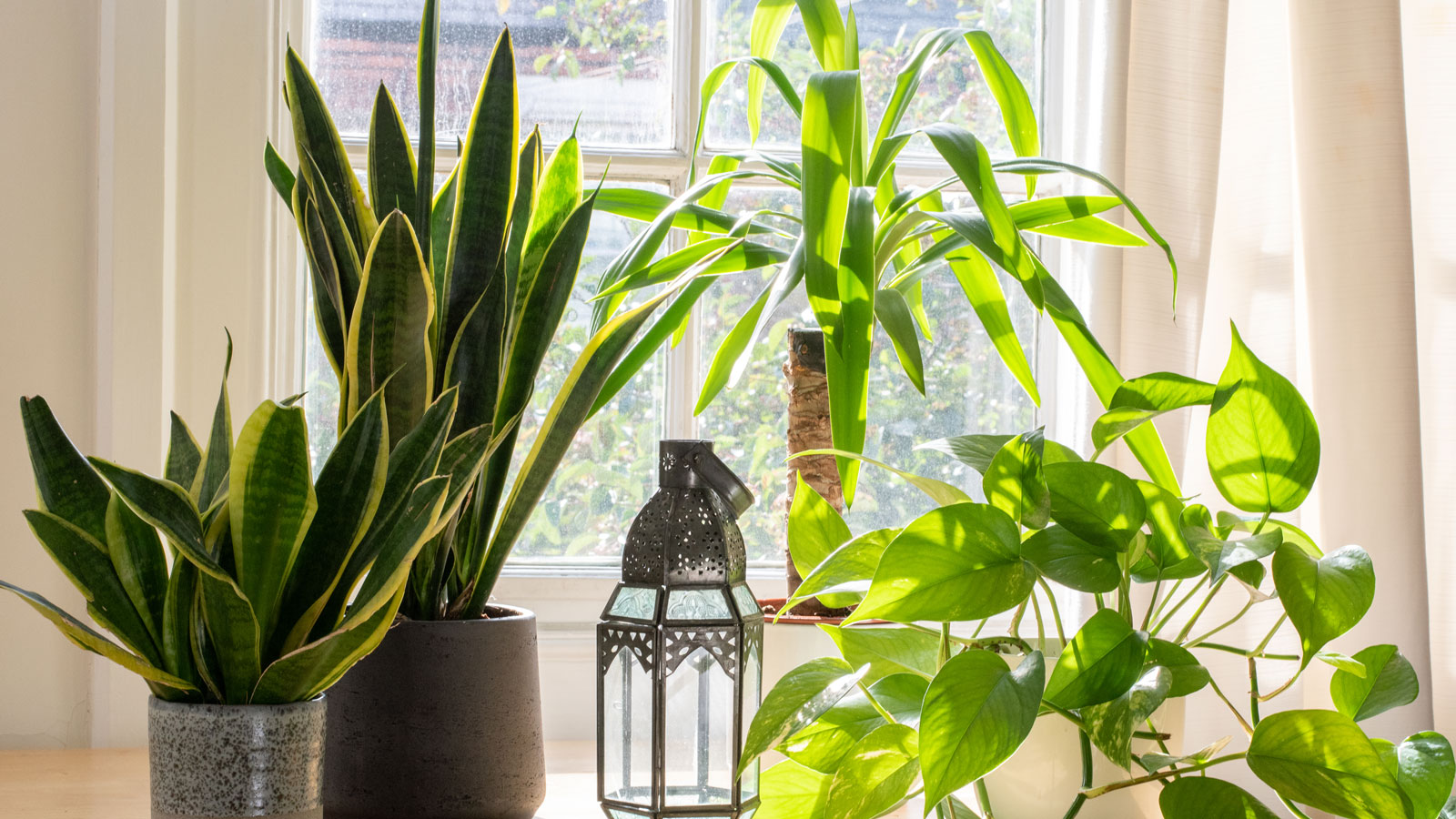
1 thought on “17 Indoor Plants for Bright Light: Soil To Sow”